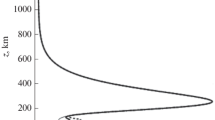Abstract
The frequency dependence of transmitted information qualitative indicators is analyzed on the example of two meridional radio links: single-hop (~2600 km) and dominant two-hop (~5100 km) for basic modes of radio wave propagation in the ionosphere. It is shown that the presence of highly efficient receiving-transmitting antennas in a radio communication system leads to the need to take the existence of a priori energetically extremely weak modes into account in the problem of radio path specification statement. In this case, we consider those formed exclusively by the mechanism of radiation transfer along the upper-angles ray trajectories in the ionospheric propagation of radio waves. If the angles of departure and arrival for such modes and the directions of the main lobes of the antenna patterns at the end points of the radio path coincide, the signal-to-noise ratio for the wave field can reach the required threshold value and ensure the successful operation of the radio communication system. This may expand the upper frequency limit for the passage of radio waves in the transition regions of jump propagation of radio waves in the ionosphere; it should be taken into account in forecasting the operation of ionospheric radio links.





Similar content being viewed by others
REFERENCES
Aizenberg, G.Z., Korotkovolnovye antenny (Shortwave Antennas), Moscow: Radio i svyaz', 1962.
Bilitza, D., Altadill, D., Truhlik, V., Shubin, V., Galkin, I., Reinisch, B., and Huang, X., International Reference Ionosphere 2016: From ionospheric climate to real-time weather predictions, Space Weather, 2017, vol. 15, pp. 418–429. https://doi.org/10.1002/2016SW00159
Deminov, M.G., Shubin, V.N., and Badin, V.I., Model of the E-layer critical frequency for the auroral region, Geomagn. Aeron. (Engl. Transl.), 2021, vol. 61, no. 5, pp. 713–720. https://doi.org/10.1134/S0016793221050054
Davis, K., Ionospheric Radio Waves, Waltham, Mass.: Blaisdell, 1969; Moscow: Mir, 1973.
Krasheninnikov, I.V. and Shubin, V.N., Frequency dependence of the wave field power parameters for limiting single-hop radio paths in low solar activity conditions, Geomagn. Aeron. (Engl. Transl.), 2020, vol. 60, no. 2, pp. 216–223.
Krasheninnikov, I.V., Pavlova, N.M., and Sitnov, Yu.S., IRI model in the problem of predicting ionospheric radio-wave propagation under conditions of high solar activity, Geomagn. Aeron. (Engl. Transl.), 2017, vol. 57, no. 6, pp. 719–726.
Kravtsov, Yu.A. and Orlov, Yu.I., Geometricheskaya optika neodnorodnykh sred (Geometric Optics of Inhomogeneous Media), Moscow: Nauka, 1980.
Makovii, V.A. and Chupeev, S.A., Signals with permutation modulation and their properties, Teor. Tekh. Radiosvyazi, 2010, no. 1, pp. 13–24.
Maslin, N.M., HF Communication: A System Approach, Pitman Publishing, 1987.
Shubin, V. N. and Deminov, M.G., Global dynamic model of critical frequency of the ionospheric F2 layer, Geomagn. Aeron. (Engl. Transl.), 2019, vol. 59, no. 4, pp. 429–440.
URSI Handbook of Ionogram Interpretation and Reduction, Piggott, W.R. and Rawer, K., Eds., Ashville, N.C.: U.S. Department of Commerce, NOAD Environmental Data Center, 1972; Moscow: Nauka, 1977.
Verhulst, T., Altadill, D., Mielich, J., et al., Vertical and oblique HF sounding with a network of synchronised ionosondes, Adv. Space Res., 2017, vol. 60, no. 8, pp. 1644–1656. https://doi.org/10.1016/j.asr.2017.06.033
Author information
Authors and Affiliations
Corresponding authors
Ethics declarations
The authors declare that they have no conflicts of interest.
Rights and permissions
About this article
Cite this article
Krasheninnikov, I.V., Shubin, V.N. Features of Forecasting the Operation of Ionospheric Radio Lines in Upper Rays Modes. Geomagn. Aeron. 63, 426–433 (2023). https://doi.org/10.1134/S0016793223600364
Received:
Revised:
Accepted:
Published:
Issue Date:
DOI: https://doi.org/10.1134/S0016793223600364




